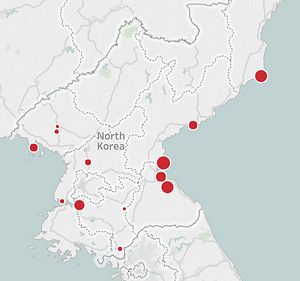North Korea has tested so many missiles lately that when news of a new test breaks, the reaction in some sectors of the public amounts to little more than “Oh, it’s just North Korea being North Korea.” 2016, in particular, was a remarkable year. We saw 24 missile tests, excluding submarine-launched missile ejection tests, and two nuclear device detonations in what was without a doubt the busiest year for North Korea’s parallel ballistic missile and nuclear weapons programs to date. As of this writing in 2017, Pyongyang has carried out eight missile tests, leaving it on track to potentially surpass last year in testing volume.
Fortunately, the Nuclear Threat Initiative has published a new database to help make sense of North Korea’s pace and breadth of testing and to keep track of the precise systems Pyongyang is developing. Prepared by Shea Cotton, a research associate at the James Martin Center for Nonproliferation Studies in Monterey, California, the database offers the most complete public dataset on North Korean missile launches, going all the way back to North Korea’s first series of Scud-B tests in 1984 under Kim Il-sung.
The database catalogs 105 missiles tests overall since 1984. Most crucially, it devotes considerable attention to highlighting the specific locations from which North Korea tests various missile systems. In the earlier days of Pyongyang’s missile programs, launch locations were used to identify various unnamed and unidentified missile systems — the Nodong, Taepodong, and Musudan, for example. Under Kim Jong-un, we’ve seen a proliferation of launch sites across the country.
Cotton, in an accompanying article, goes into more detail on why this proliferation in launch sites is of “immense” strategic importance. It all comes down, effectively, to two factors. First, North Korea is more confident in the reliability of its shorter-range systems and is effectively practicing for nuclear war with, for example, its salvo launches of extended range Scuds (most recently in March 2017). Second, North Korea’s missile forces are diversifying to include intermediate-range ballistic missiles (the Musudan), submarine-launched ballistic missiles (the KN-11), and even a new anti-ship ballistic missile (the KN-17). The latter two systems have seen development and testing out of Sinpo.
The real utility of a resource like this database is that it helps analysts of North Korea wrap their head around the “forest” of North Korea’s missile program instead of getting too bogged down in the “trees” of individual tests. No doubt, examining each test as it occurs is important and revealing of Pyongyang’s progress and priorities, but the larger picture over 33 years of missile testing shows a country in hot pursuit of a diversified arsenal of missiles for nuclear warfighting.
































